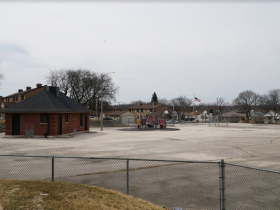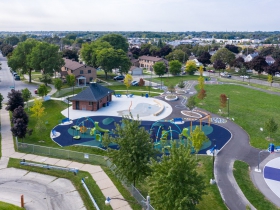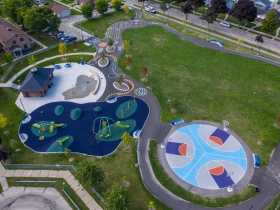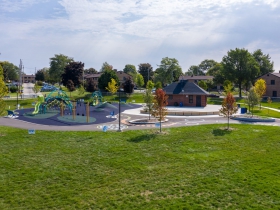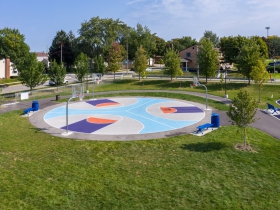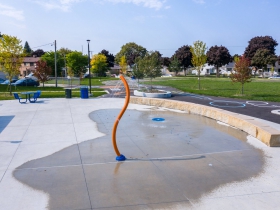MPS Revamps Southgate Playfield
Playfield with 77% less asphalt opens. Plus: alll the week's real estate news.
A southside park has received a makeover.
Milwaukee Recreation cut the virtual ribbon on a revamped Southgate Playfield, 3300 S. 25th St., earlier this month.
The playfield, one of 52 managed by Milwaukee Public Schools‘ recreation department, received new playground equipment, a splash play area, natural turf playfield, shade trees, walking loop and a basketball court.
What’s gone is a whole lot of asphalt. Like many of its playfields, much of the 1.9-acre lot was covered in pavement. A grant from the Milwaukee Metropolitan Sewerage District supported removing that asphalt and reducing runoff from the site. The asphalt footprint at the property was reduced by 77 percent according to Milwaukee Recreation.
The park, formerly known as Southlawn Playfield, serves as the northwest entry point into the Southlawn housing development owned and operated by the Housing Authority of the City of Milwaukee. The new name matches the city’s name for the broader neighborhood.
The three basketball hoops at the playfield have circular courts, the first such courts ever created by the school district.
It’s the third revamped playfield completed since MPS kicked off the revitalization effort. It follows similar upgrades at Columbia Playfield and Custer Playfield.
In 2014, a $25 million, 10-year plan was unveiled to address its playfields. An equity prioritization effort guides which playfields get upgraded first.
Many of Milwaukee Recreation’s playfields, covering more than 300 acres, were originally constructed in the 1920s and 1930s.
A city permit lists Zimmerman Architectural Studios serving as the architect of record, Platt Construction handling the general contracting and SmithGroup providing engineering and design support.
Another southside playfield, Modrzejewski Playfield, will soon see be upgraded.
The City of Milwaukee is also upgrading its small parks through its MKE Plays program.
Photos
Ribbon Cutting Video
Weekly Recap
Brady Street Parking Lot Goes Permeable
The Brady Street Public Parking Lot is located between N. Arlington Pl. and N. Warren Ave., with only pedestrian access to its namesake street. It runs east-west, hidden behind the shops and apartments of the Passeggio on Brady Street. The city-owned lot was developed in tandem with the Passeggio in 1996, with four spaces reserved for its residential tenants. The lot also is home to two Zipcars, ready and waiting at $12 per hour, and two electric charging stations, neither of which has yet been installed. There are 51 metered spaces for the public, but on a recent visit, no meters were attached to their mounts, so parking was free.
The parking surface itself is immaculate, and freshly laid as part of a green infrastructure project started in June and slated for July completion. Although such minor details as the installation of a means for the collection of parking revenue are not yet in place, the heavy work has been done, and a parking lot is, by definition, something you build from the ground up.
The driving lanes are finished with new grey permeable concrete pavers, surrounded by a contrasting fresh coat of black asphalt at the parking spaces, all nicely set off in reflective yellow paint, including some designating ADA parking spots. In addition, the Department of Public Works upgraded the lighting, according to Brian DeNeve, DPW Marketing and Communications Manager.
“We calculated that up to 26,672 gallons are captured by the pavers per rain event at the Brady St. location,” he writes Urban Milwaukee in an email message.
The Architecture of a Pandemic
The COVID-19 pandemic is reshaping the way cities look in obvious and subtle ways. Traffic is down, office buildings are mostly empty, markers line sidewalks six feet from one another and white tents have appeared in unlikely places.
The latest change in Milwaukee is the creation of a large COVID-19 testing site at Miller Park. A large white tent can be found in the stadium’s Miller Lot, located at the intersection of S. 44th Ct. and Selig Dr.
The free, no-appointment site will open to the public on October 19th, operating Monday through Friday, 11:00 a.m. to 6:00 p.m.
The tent, planned to include six lanes, will allow drive-through or walk-up testing through the winter in a climate-controlled facility. Two large generators can be spotted outside the facility.
Affordable Housing Project Secures Cleanup Loan for Former Factories
The city’s largest-ever private affordable housing development took another step forward Thursday.
The Community Within the Corridor development team, a partnership of Scott Crawford Inc. and Roers Companies, secured a $750,000 environmental cleanup loan to redevelop a series of former factory buildings. The loan would be used to support the creation of 197 units of housing spread across a $59 million redevelopment of the two-block campus.
From 1910 to 1930 the complex, located on the north side of the intersection of N. 32nd St. and W. Center St., was used for the manufacture of trunks, suitcases and travel bags according to a city report. After that Briggs & Stratton used it to manufacture gasoline engines until 1989. It was used as a warehouse until recently, now much of the complex is vacant.
The board of the Redevelopment Authority of the City of Milwaukee (RACM) unanimously approved the loan from its Brownfield Revolving Loan Fund at its Thursday meeting. The funds come from a grant from the federal Environmental Protection Agency (EPA). RACM senior environmental project engineer Tory Kress said the city has issued 15 loans to date, with 274 acres of land cleaned and $500 million in private investment created. “All our loans are performing and our model continues to be one that the EPA showcases,” said Kress.
Historic Designation Could Halt Demolition of Forest Home Library
The Historic Preservation Commission finds itself poised to debate the historic merits of a city-owned, mid-century modern building.
An application to historically designate the former Forest Home Library, 1432 W. Forest Home Ave., has been filed by Eric Vogel, an educator and architectural historian, and Kelsey Kuehn, a research assistant, both of Vogel Design Group.
“It’s probably the most significant modernist library in the state of Wisconsin built in the 20th century,” Vogel said in an interview. “These important mid-century buildings are now more than 50 years and it’s time we preserve them.” He said its preservation would complement the 19th century buildings preserved on W. Historic Mitchell, located a block to the north.
The library, which closed in 2017 when the city opened a new library at 906 W. Historic Mitchell St., is poised to be sold by the city and demolished. ICAP Development would acquire the property and develop a $5 million, 18,000-square-foot medical office building for an office tenant.
Journal Sentinel Redevelopment Secures Two Environmental Cleanup Loans
J. Jeffers & Co. secured two low-interest environmental cleanup loans Thursday to advance its redevelopment of the former Journal Sentinel complex at 333 W. State St.
The firm is advancing two separate housing redevelopments within the full block complex. The first would convert a 1962 addition at the southwest corner of W. State St. and N. Old World Third St. into a 77-unit (189 bedroom) affordable housing development for Milwaukee Area Technical College students. A second phase would redevelop the signature Journal Building at the southeast corner of W. State St. and N. Vel R. Phillips Ave. into up to 103 units.
The board of the Redevelopment Authority of the City of Milwaukee (RACM) unanimously approved $1.7 million in loans from its Brownfield Revolving Loan Fund at its Thursday meeting. Originally provided by the federal Environmental Protection Agency (EPA), the funds have already been lent and returned (revolved). RACM senior environmental project engineer Tory Kress said the city has issued 15 loans to date, with 274 acres of land cleaned and $500 million in private investment created. “All our loans are performing and our model continues to be one that the EPA showcases,” said Kress.
Wangard Partners Announces New President, Board of Directors
Wangard Partners, Inc. (Wangard), a Milwaukee-based full-service real estate company, announced today the implementation of a long-term succession plan, which includes emerging leaders who will take on key, new roles in the company, as well as the creation of a new Board of Directors.
“The growth of our organization over the last thirty years has been significant, and we anticipate even larger growth in the near future as we grow our investment footprint,” said Stu Wangard, Chairman of the Board of Directors and CEO of Wangard Partners. “Our Wangard organization is incredibly talented, and I’m thrilled to announce the promotion of these leaders, who, along with the entire Wangard organization, will steer the company toward success for years to come.”
Matt Moroney will serve as President and Chief Operating Officer, broadening his well-established leadership in the company’s operations and in the community. Matt is a respected leader, and as President and COO, he will draw on his strength and experience of collaborating with and unifying diverse groups of individuals and organizations. Burton Metz will expand his role to serve as President of Investments & Acquisitions and will continue to spearhead and innovate critical aspects of our business and drive new opportunities for our investors and partners. Wangard begins the next great chapter with an exceptional leadership team that includes many emerging leaders who will help the company grow.
Downtown’s New Voting Rights Mural
Artist Shepard Fairey has completed his “Voting Rights are Human Rights” mural on the north side of the six-story Colby Abbot Building, 759 N. Milwaukee St.
Fairey, famous for his Hope image of then-candidate Barack Obama, painted the mural with his Obey Giant team.
The central image in the mural is of an African American male at a 1960s protest looking skyward surrounded by artwork provided by the Wisconsin artists. The central figure was captured by photographer Steve Schapiro, who documented civil rights protests in the 1960s. “As I looked through his numerous beautiful and powerful photos, we discussed the possibility of collaborating on the spot,” wrote Fairey in describing the inspiration behind the piece and his first meeting with Schapiro.
Meet the 2021 Acre Class
Members of the 2021 class of the Associates in Commercial Real Estate program were announced this week.
The program is designed to train people of color for careers in commercial real estate. Program graduates, now numbering 280, can be found working as real estate developers, construction executives, non-profit leaders and elected officials.
Program manager LISC Milwaukee announced the 24 candidates for the 2020-2021 program were selected from a field of 85 applicants.
About That Proposed Street Lighting Fee
One of the most notable impacts for residents of Milwaukee’s proposed $1.6 billion 2021 budget is a new street lighting fee.
The city’s budget office estimates the average homeowner would pay $45 annually. Property owners would see the fee on their quarterly water bills.
The fee will raise approximately $10.5 million by levying a charge against privately-owned properties. The proposed structure is similar to how the city levies the snow & ice removal fee: a per-foot rate would be set and multiplied by the amount of street frontage a property has.
Foxconn Won’t Get State Tax Credits
Foxconn won’t be awarded any tax credits unless it restructures its contract with the state, the company was informed in a letter by Missy Hughes, the CEO of the Wisconsin Economic Development Corporation, to Dr. Jay Lee, Vice Chairman of Foxconn Technology Group.
The Taiwanese-based company has signed a contract for the biggest subsidy ever promised a foreign-owned company by an American government in November 2017, when Republican Scott Walker was governor. But the contract stipulated that the company would be building a Gen 10.5 LCD facility, which has never materialized. The company has also gone gone back on its promise to invest $10 billion on its manufacturing plant and create 13,000 jobs, changing and down sizing its plans numerous times since then.
The company had provided data to the state claiming it hired 550 people in 2019, in excess of the 520 required under its contract, but the WEDC estimated only 281 would qualify under the contract. It did not say why, but employees could be ruled ineligible if they made less than $30,000 per year or were not based in Wisconsin.
Moreover, the letter from Hughes made it clear that no credits can be ever be awarded until a new contract is created.
City Hires New Deconstruction Contractor
The City of Milwaukee is making yet another attempt at deconstructing, not demolishing, dilapidated homes it acquires through property tax foreclosure.
The Department of Neighborhood Services (DNS) hired White Glove Group to replace Spencer Renovation & Construction. The city moved to fire Spencer in March as the firm was months behind on work and unresponsive.
White Glove will now attempt to fulfill the Common Council’s 2018 vision of creating jobs and protecting the environment by salvaging materials from old homes instead of sending almost everything to a landfill. It is that latter factor that is supposed to offset the increased cost of using more manual labor to disassemble buildings versus mechanical demolition. Materials, including old-growth lumber, are to be routed to contractors and home improvement stores like Community Warehouse.
If you think stories like this are important, become a member of Urban Milwaukee and help support real, independent journalism. Plus you get some cool added benefits.
Plats and Parcels
-
New Third Ward Tower Will Be Milwaukee’s Priciest
 Mar 3rd, 2024 by Jeramey Jannene
Mar 3rd, 2024 by Jeramey Jannene
-
New Corporate Headquarters, 130 Jobs For Downtown
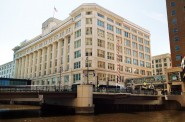 Feb 25th, 2024 by Jeramey Jannene
Feb 25th, 2024 by Jeramey Jannene
-
A Four-Way Preservation Fight Over Wisconsin Avenue
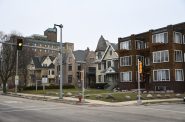 Feb 18th, 2024 by Jeramey Jannene
Feb 18th, 2024 by Jeramey Jannene



